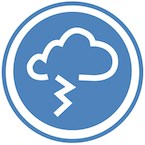|
Navigating Our Climate Connections
Prince William Forest Park has been used by families for decades to stay active and maintain a healthy lifestyle through outdoor recreation. As the climate changes, so do the opportunities to recreate in the park. Discover more about climate impacts that are happening today in the infographic or click on the following activities to learn more: biking, camping, hiking, and fishing.

As average temperatures continue to rise, so are the average numbers of 95+˚F days. This means warm days are becoming hot and hot days are becoming hotter.1
Tick populations have increased because changes in temperature and humidity have made the D.C. region ideal habitat for them. Ticks spread diseases like Lyme or Rocky Mountain spotted fever.2 In addition to the expected spring floods, flash flooding has increased in the summer and fall seasons as heavy rain become more common throughout the year.4
Many effects of climate change are impacting the recreational activities within the park. Higher temperatures are fueling extreme weather that is impacting your opportunity to have an adventure in the park. Some of the extreme conditions of today may become the norm in the coming years. Before your visit check for road closures and trail damage on our Alerts page. Plan on drinking more water to stay hydrated on hot days and dress accordingly to avoid contracting Lyme disease from tick bites. Furthermore, be sure to check the weather forecast to avoid dangerous weather. The most recent climate research shows that in the park’s surrounding region:
Impacts to Recreation
With a changing climate, rising average temperatures and more frequent extreme heat days are increasing the risk of heat exhaustion. Hikers should check heat indices and carry the appropriate amount of water. Wearing light colored clothing and a hat not only protect against sun exposure, but also protects against tick bites. Hiking plans are also impacted by more frequent and intense storms which can cause washouts, downed trees on trails or damage to foot-bridges.
Increasing temperatures and more frequent hot days mean that precautions need to be taken to stay hydrated and beat the heat. Bikers should check heat indices and the weather forecast before their visit to avoid heat exhaustion. After severe storms, park alerts should be monitored to ensure that trails have not been closed due to flooding, washouts, or downed trees.
Cabin camps and tent campgrounds are vulnerable to damage from intense storms, such as falling trees, wind damage, and extreme precipitation. Longer frost-free seasons lead to a greater number of ticks and mosquitoes. Campers should take precautions, such as wearing insect repellant, to protect themselves from bites that could transmit diseases like Lyme disease.
Intense rainfall causes streams to flood and erodes stream banks which will change the fishing experience in the park. Eroded soil is washed into streams making the water silty, which puts stress on fish and other aquatic species. Fish are also affected by the warming stream temperatures meaning climate change is impacting the abundance and type of fish found in the park.
See how you can help reduce the impacts of climate change by being climate friendly:
References
1. Ingram, K. T., Dow, K., Carter, L., & Anderson, J. (Eds.). (2013). Climate of the Southeast United States: Variability, Change, Impacts, and Vulnerability. Island Press, 23.
2. Walsh, J., Wuebbles, D., Hayhoe, K., Kossin, J., Kunkel, K., Stephens, G., . . . Somerville, R. (2014): Ch. 2: Our Changing Climate. Climate Change Impacts in the United States: The Third National Climate Assessment, J. M. Melillo, Terese (T.C.) Richmond, and G. W. Yohe, Eds., U.S. Global Change Research Program, 40. doi:10.7930/J0KW5CXT.
3. Diffenbaugh, N. S., Scherer, M. & Trapp, R. J. (2013). Robust increases in severe thunderstorm environments in response to greenhouse forcing. Proceedings of the National Academy of Sciences, 110,16361-16366, doi:10.1073/pnas.1307758110.
4. Schramm, A., & Loehman, R. (2011). Understanding the science of climate change: Talking points - Impacts to the Eastern Woodlands and Forests. Natural Resource Report NPS/NRSS/CCRP/NRR-2011/470. National Park Service, Fort Collins, Colorado, 33.
5. Gonzalez, P. (2013). Climate Change and Impacts for the National Parks of Washington, DC, USA. National Park Service, Washington, DC.
6. Carter, L. M., Jones, J. W., Berry, V., Murley, J. F., Obeysekera, J., Schramm, P. J., & Wear, D. (2014). Chapter 17: Southeast and the Caribbean. Climate Change Impacts in the United States: The Third National Climate Assessment,C J. M. Melillo, Terese (T.C.) Richmond, and G. W. Yohe, Eds., U.S. Global Change Research Program, 399. doi:10.7930/J0NP22CB.
7. Walsh, J., Wuebbles, D., Hayhoe, K., Kossin, J., Kunkel, K., Stephens, G., . . . Somerville, R. (2014): Chapter 2: Our Changing Climate. Climate Change Impacts in the United States: The Third National Climate Assessment, J. M. Melillo, Terese (T.C.) Richmond, and G. W. Yohe, Eds., U.S. Global Change Research Program, 37. doi:10.7930/J0KW5CXT.
8. CDC (2013). Lyme Disease Data. Centers for Disease Control. National Center for Emerging and Zoonotic Infectious Diseases.Division of Vector-Borne Diseases. December 6.
|
Last updated: April 10, 2015








